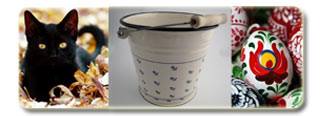
HISTORY
The Land of Hungary
This small country is one of the great survivors of history: states and empires emerged, expanded or disintegrated and disappeared around it. Hungary and the Hungarian nation survived the devastation of the Tartars and Turks, Habsburgs and Russians in the Carpathian Basin; survived the fact that it belonged among the losers of both world wars. A stormy history? The national anthem describes the Hungarians as “people torn by fate”.
We learnt and became tempered in the tormenting storms of the world: you can experience a particular organic link between the old and new, between history and the present-day in this country, which is still keenly safeguarding its traditions, culture and arts, but was always perceptive to what is new, different and the future.


CUSTOMS AND TRADITIONS
Easter in Hungary

In the Hungarian folk tradition each Sunday before Easter had a special name: the 2nd was “Gulash Sunday”, the 5th was the “Black Sunday”, the 6th was named as “Palm Sunday”. The last Sunday before Easter was always part of the Easter celebrations.
One of the old Easter traditions is the “villőzés” or “green sprigging” (a fertility boosting tradition). Each girl and young woman was tapped with a green sprig. On the Saturday before the “Palm Sunday” children picked some catkin and had them blessed in the church so that they could keep all trouble away. Some Csango’s (Hungarians living around the Ghimes Mountains in Romania) still keep the tradition of blowing willow whistle to “wake up” the spring. In many places, people walk along the border and make noise to keep away the evil spirits. On Maundy Thursday boys replace the bells taken to Rome with rattles.
On this day you also eat something green like spinach or lettuce. Many years ago people only ate once a day in the period of Lent. The used oil or butter for cooking, they did not eat lard or meat, only fresh or dried vegetables. The rules of the Church have changed a lot since and are not that strict any more. The restraint now only applies to the last week, and to Good Friday. The last week, the Passion Week, starts with Palm Sunday. In the evening of Maundy Thursday the bells go silent, according to the tradition they are taken to Rome with the aim of visiting the Pope. On Holy Saturday we prepare for the resurrection of Jesus.
People ate meals that were specific to that day – like sour soup made from bran and possibly eggs. The day of resurrection is Easter Sunday. That is when the Easter eggs are presented. The smoked gammon already gets on the table for tasting on Saturday night as a symbol of the closure of the Lent Period. On Sunday morning it is served with eggs and horse radish. On Easter Monday, which is also know as “Ducking Monday”, takes the sprinkling place. Until some time back, boys used to drag girls and young women to a well or to a nearby spring and pour buckets of water over their heads. This is a symbol of purification and of the revival of fertility.
This tradition is still alive, although in a blender way: boys sprinkle perfume or perfumed water on girls. Finally, the list of Easter traditions is closed on “White Sunday” when girls prepare a plate with Easter eggs, milk loaf and some drinks on it. With this, girls make eternal friends.

LEGENDS
Legendary Hungarians in history
Ferenc Puskas
Franz Liszt

